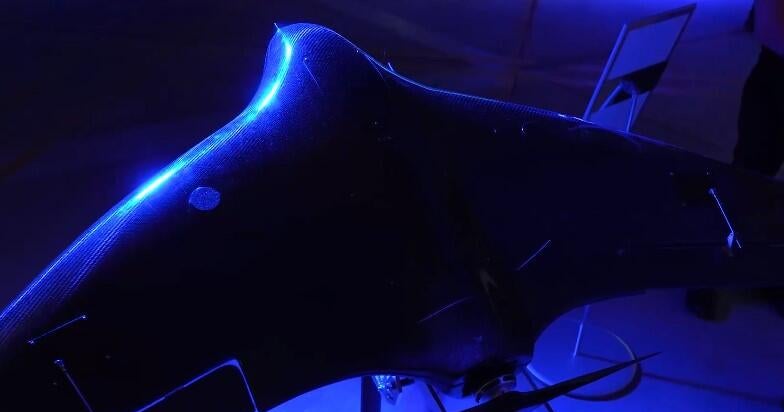In a significant stride towards bolstering its defense capabilities, Ukraine has introduced a new domestically developed drone aimed at countering Iranian-made Shahed explosive drones deployed by Russia. Amid concerns regarding the reliability of U.S. support, President Volodymyr Zelenskyy unveiled this interceptor system, known as STING, during a recent defense meeting in Kyiv. As the conflict continues to escalate, the Ukrainian military’s advancements in drone technology highlight the nation’s commitment to self-reliance in its defense against persistent aerial threats.
| Article Subheadings |
|---|
| 1) Introduction of the New Drone Technology |
| 2) Impact of Russia’s Shahed Drones on Ukraine |
| 3) Development and Production of STING |
| 4) The Future of Ukraine’s Defense Capabilities |
| 5) Summary and Implications |
Introduction of the New Drone Technology
As Ukraine faces intensified aerial attacks from Russia, the launch of the new STING interceptor drone represents a strategic development in the conflict. Announced by Ukrainian President Volodymyr Zelenskyy, the drone aims to enhance Ukraine’s capabilities to neutralize the threat posed by Russian Shahed drones, which have been persistently targeting Ukrainian infrastructure. The unveiling took place during a meeting between Zelenskyy and Belgian Prime Minister Bart de Wever, showcasing collaborative efforts towards bolstering Ukraine’s defense resilience.
The STING drones are designed to intercept and destroy aerial threats, shifting the focus away from reliance on expensive air defense systems provided by foreign allies. Amid increasing uncertainty regarding the reliability of external military support, this domestic innovation is essential for Ukraine’s long-term defense strategy.
Impact of Russia’s Shahed Drones on Ukraine
The ubiquitous deployment of Iranian-made Shahed drones by Russia has significantly complicated Ukraine’s defense landscape. These drones, while relatively low-cost at around $35,000 each, have proven effective at circumventing traditional air defenses due to their low-altitude operations and hard-to-detect characteristics. According to reports, Russia has launched approximately 15,000 of these drones since introducing them into the conflict in August 2022.
The impact of these drones has been devastating; they target civilian infrastructure, leading to deaths and widespread destruction. For instance, attacks in cities like Kharkiv have resulted in casualties among civilians, emphasizing the urgent need for effective countermeasures.
“Even though Ukraine shoots down a majority of the Shaheds launched, they still pose a significant threat,”
said military analysts, highlighting concerns over the increasing number and sophistication of these threats.
Development and Production of STING
The STING drones were developed by Wild Hornets, a Ukrainian non-profit organization focused on enhancing the country’s defense technology. Production of these interceptors began at the start of the year, and the organization has already claimed to have successfully downed more than 20 Shahed drones in a short span. The STING interception system has been produced in significant volume to meet the operational demands of the Ukrainian Armed Forces.
Despite logistical challenges, such as sourcing components from China due to the lack of locally available alternatives, Wild Hornets is committed to increasing production capacity significantly. Their goal is to ultimately substitute Chinese parts with locally-made alternatives, ensuring the development of a self-sufficient domestic defense production ecosystem.
The Future of Ukraine’s Defense Capabilities
As Ukraine continues to navigate the complexities of modern warfare, the STING interceptors underline a major shift in defense strategy. There is a concerted effort towards enhancing domestic production capabilities amid concerns about the adequacy and consistency of support from Western allies. Recent discussions around cooperation agreements, such as the one signed between Ukraine and Belgium, point to a broader strategy of consolidating resources and expertise to strengthen national defense.
Furthermore, Ukrainian military leadership, such as General Oleksandr Syrskyi, underscores the country’s growing autonomous capabilities in terms of defense production, particularly in artillery and electronic warfare systems. This shift not only positions Ukraine to deal with current threats but also sets a framework for future resilience.
Summary and Implications
In conclusion, the development of the STING drone interceptors is a pivotal advancement in Ukraine’s defense strategy amid ongoing conflict. By investing in indigenous technologies and fostering greater self-reliance, Ukraine aims to mitigate its dependence on external support in countering aerial threats. As the situation unfolds, the effectiveness of these new capabilities will be crucial in shaping Ukraine’s response to ongoing and escalating challenges posed by adversarial forces.
| No. | Key Points |
|---|---|
| 1 | Ukraine has launched the STING interceptor drone to counter Russian Shahed drones. |
| 2 | Russian Shahed drones have inflicted significant civilian casualties and infrastructure damage. |
| 3 | Wild Hornets is actively producing STING drones, aiming for greater self-sufficiency. |
| 4 | Collaborations with international partners are underway to bolster defense capabilities. |
| 5 | The development of new defense technologies signifies a shift in Ukraine’s military strategy. |
Summary
The introduction of the STING interceptor drone system demonstrates Ukraine’s commitment to enhancing its defense capabilities in the face of ongoing threats. As the nation continues to innovate and develop its military technologies, these advancements may play a crucial role in shaping the future of its defense strategies and mitigating the impacts of foreign aerial assaults.
Frequently Asked Questions
Question: What are Shahed drones, and how do they impact Ukraine?
Shahed drones are Iranian-made unmanned aerial vehicles used by Russia to target Ukrainian infrastructure. They have been effective in causing significant damage and civilian casualties.
Question: What is the STING interceptor drone?
The STING interceptor drone is a domestically developed UAV designed by the Ukrainian non-profit Wild Hornets to neutralize aerial threats posed by Shahed drones.
Question: How is Ukraine boosting its defense production capabilities?
Ukraine is enhancing its defense production through domestic innovations like the STING drone, partnerships with international allies, and a focus on self-reliance in military technology.


